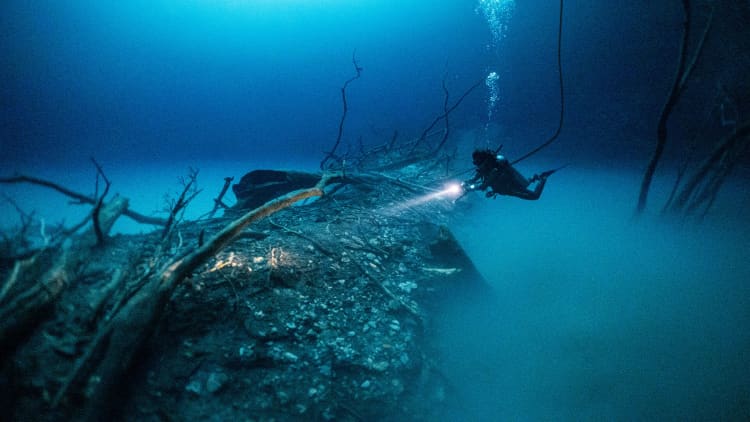Denmark’s navy said on Nov. 20, 2024 it was shadowing a Chinese cargo vessel in the Baltic Sea, a day after Finland and Sweden opened investigations into suspected sabotage of two severed undersea telecoms cables.
Mikkel Berg Pedersen | Ritzau Scanpix | Afp via Getty Images
Geopolitical tensions are brewing globally over the cutting of subsea cables — critical infrastructure powering cross-border internet connectivity — in the Baltic Sea.
The severing of the cables prompted warnings of “sabotage” and potential “hybrid” warfare targeting key infrastructure in the West amid further escalations in the ongoing war in Ukraine.
CNBC explains all you need to know about the undersea incident — and why it’s ratcheting up global geopolitical tensions.
What happened, exactly?
Last week, two undersea cables were severed in the Baltic Sea, raising suspicions that subsea communication systems may be the latest target of sabotage against the West, as it clashes with Russia over the country’s invasion of Ukraine.
One of the cables disrupted was C-Lion1, which links Finland and Germany and is owned by Cinia, a Finnish state-controlled IT firm. Spanning nearly 1,200 kilometers (730 miles), it is the only direct connection of its kind between Finland and Central Europe.
A data visualization map showing the C-Lion1 undersea cable which connected Finland and Germany.
CNBC graphic using data from Telegeography
The other cable damaged was one connecting Lithuania and Sweden, BCS East West Interlink. Arelion, the company which owns it, told CNBC data traffic that would have gone through it has been rerouted to alternatives. Data traffic flowing through the cable is carried by Telia Lithuania.
“The vessel repairing the cable arrived at the location a week ago and the cable should be fixed within the next few days, weather permitting,” Arelion spokesman Martin Sjögren told CNBC by email.
Arelion cannot yet comment on how the cable was damaged, he said, adding that the incident is being investigated by Swedish police.
But repairing subsea cables isn’t easy, according to Andy Champagne, senior vice president and chief technology officer of Akamai Labs.
“While we’re linked together with a complex physical web of fiber optic cables over land, the topology becomes more challenging once we plunge into the oceans,” he told CNBC. “It’s really complex to install subsea cables. And, when there is an issue with a subsea cable, repairing it is a non-trivial job.”
What are subsea cables?
Subsea cables are massive fiber-optic cables laid on the seabed, which carry data like webpages, email, and video calls between continents. They are the backbone of the global internet, delivering 99% of the world’s intercontinental data traffic.
“Undersea cables are part of critical national infrastructure carrying telecommunications between nations and continents,” Martin Lee, EMEA lead at Cisco Talos, told CNBC.
“Their physical location exposes them to many natural threats such as salt water corrosion and landslides, as well as man-made threats, which may be accidental due to fishing activity or malicious in nature.”

Lee said businesses “need to understand their exposure to risks such as these.” While, for some firms a temporary slowdown in international traffic caused by rerouting might not be an issue, others can’t afford that disruption.
“Businesses that rely on fast, instantaneous connections, such as anyone requiring video conferencing or transferring large amounts of data, are massively exposed to the consequences of cable disruption,“ Lee said.
Who is to blame?
An investigation is under way, with authorities look to determine the perpetrator. The attack has so far not been attributed to a single entity or country.
On Thursday, Finnish Foreign Minister Elina Valtonen told CNBC’s “Squawk Box Europe” that the country is “in close contact with China.”

Authorities in several EU countries are tracking a Chinese vessel. On Wednesday, a Wall Street Journal report said investigators suspect the crew of the ship deliberately severed the cables by dragging its anchor along the Baltic seabed.
CNBC was unable to independently verify the report. The Chinese embassy in London was not immediately available for comment when contacted by CNBC.
Valtonen said the incident highlights how EU nations need to “focus a lot more on the resilience of the overall connectivity, which is so important, both when comes to data [and] energy infrastructure.”
“If this was a deliberate attack, then it would have also implications for the foreign education policy,” she added.
Germany, without naming a specific potential suspect, said it believes the cable cut was an act of “sabotage” and possible “hybrid” warfare.
In a joint statement, the foreign ministers of Finland and Germany said the incident “immediately raises suspicions of intentional damage,” adding that a “thorough investigation” is being carried out.
“Our European security is not only under threat from Russia’s war of aggression against Ukraine, but also from hybrid warfare by malicious actors. Safeguarding our shared critical infrastructure is vital to our security and the resilience of our societies,” they added.
